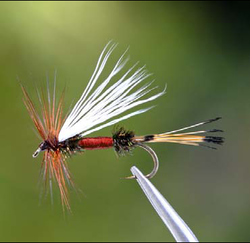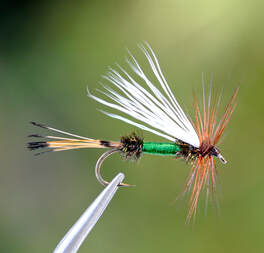Fly of the Month 10.10 Caddis Coachman
When Tom Adams sent me the information on this month’s fly and indicated that this month’s fly was a Coachman Caddis, I immediately read that to mean Royal Coachman Caddis. So you can imagine my surprise when I opened up the picture file and saw this:
That’s got a great body! If it is a derivative of the Royal Coachman, it’s got to be red! Since he researched the recipe, I didn’t want to necessarily question him but, if my assumption about Royal was wrong, I wanted to correct it. So I emailed Tom and asked. His response was: “Sorry about the confusion. I have found a number of patterns that interchange red
and green so I did not think anything of it.”
Included as an attachment to that email was the photo. Now that is what I expected to see but I also got to thinking about some other variations and one in particular that is favored by alumni of a particular university in Knoxville. Those folks add an orange floss body to anything and you get an Tennessee Wulff or Tennessee Coachman or Tennessee Humpy. And, speaking of the Humpy, why couldn’t you make it yellow.
Note: Please don’t take the discussion above as my endorsement of tying any pattern with a body that matches your school colors. While a fly with a pale blue body matching the colors from a university found to the west of Raleigh might look nice in a shadow box, I don’t think it would be productive on the stream.
Fly of the Month 10.10 Caddis Coachman
Hook: Dry Fly, 3x long, 1X fine, perfect bend, Mustad 94833, Size: 12, 14, 16 , 18, 20, 22
Thread: 8/0 Uni or equivalent in Brown
Tail: Golden Pheasant Tippet
Body: Peacock Herl and Red Floss
Wing: Calf Tail
Hackle: Coachman Brown
Directions :
1) Starting three eyelenghts from the eye, wrap hook to point above hook barb with brown thread in tight wraps. Let bobbin hang.
2) Select five or six Golden Pheasant tippet feathers aligning the tips before cutting. Tie in with a soft wrap or two leaving about a shaft length unfettered. Continue the wrap adding pressure and after eight or ten turns cut remaining material. Wrap forward to neaten the profile and wrap back to the tie in point of the tail. Let bobbin hang.
3 ) Select peacock herl and tie in. The herl can not be tied in very close to the end of the feather (it will break when you are almost finished ) noting the feather has a long and short barb side. Tie in the short side in and wrap the herl from the rearmost tie of the tail forward about six wraps. Tie off and let the bobbin hang.
4) Select a section about three inches long of red floss (single strand) and tie with two or three wraps of the brown thread. Take the bobbin
toward the eye and stop slightly past the halfway mark and let the bobbin hang.
5) Begin wrapping the floss being careful not to pick it with fingers or nails and overlap the wraps up to the thread bobbin. You may want to make two, front to back wraps to add some “bulk” to the floss. Tie off with two or three wraps of brown thread and trim excess letting the bobbin hang.
6) Repeat step three with peacock herl.
7) Select the calf tail wing material and tie in with a soft wrap immediately in front of the second peacock herl. Finished off with firm wraps,
covering the tie in but stopping short of the eye. Return the thread to the tie in point of the calf tail and let the bobbin hang.
8) Select a Coachman Brown rooster hackle feather with barbs about one and one half of the hook gape. Strip a quarter inch of barbs and tie in, forward of the tie in for the wing, with the shiny side up. Leave the bobbin two or three eyelengths back from the eye. Begin wrapping the hackle forward in tight advancing wraps stopping two eyelengths back from the eye. Tie in the hackle, cut the excess hackle and wrap firmly leaving room at the eye. Whip finish, cut thread and apply head cement.
- Tom Adams, Tim Wilhelm
When Tom Adams sent me the information on this month’s fly and indicated that this month’s fly was a Coachman Caddis, I immediately read that to mean Royal Coachman Caddis. So you can imagine my surprise when I opened up the picture file and saw this:
That’s got a great body! If it is a derivative of the Royal Coachman, it’s got to be red! Since he researched the recipe, I didn’t want to necessarily question him but, if my assumption about Royal was wrong, I wanted to correct it. So I emailed Tom and asked. His response was: “Sorry about the confusion. I have found a number of patterns that interchange red
and green so I did not think anything of it.”
Included as an attachment to that email was the photo. Now that is what I expected to see but I also got to thinking about some other variations and one in particular that is favored by alumni of a particular university in Knoxville. Those folks add an orange floss body to anything and you get an Tennessee Wulff or Tennessee Coachman or Tennessee Humpy. And, speaking of the Humpy, why couldn’t you make it yellow.
Note: Please don’t take the discussion above as my endorsement of tying any pattern with a body that matches your school colors. While a fly with a pale blue body matching the colors from a university found to the west of Raleigh might look nice in a shadow box, I don’t think it would be productive on the stream.
Fly of the Month 10.10 Caddis Coachman
Hook: Dry Fly, 3x long, 1X fine, perfect bend, Mustad 94833, Size: 12, 14, 16 , 18, 20, 22
Thread: 8/0 Uni or equivalent in Brown
Tail: Golden Pheasant Tippet
Body: Peacock Herl and Red Floss
Wing: Calf Tail
Hackle: Coachman Brown
Directions :
1) Starting three eyelenghts from the eye, wrap hook to point above hook barb with brown thread in tight wraps. Let bobbin hang.
2) Select five or six Golden Pheasant tippet feathers aligning the tips before cutting. Tie in with a soft wrap or two leaving about a shaft length unfettered. Continue the wrap adding pressure and after eight or ten turns cut remaining material. Wrap forward to neaten the profile and wrap back to the tie in point of the tail. Let bobbin hang.
3 ) Select peacock herl and tie in. The herl can not be tied in very close to the end of the feather (it will break when you are almost finished ) noting the feather has a long and short barb side. Tie in the short side in and wrap the herl from the rearmost tie of the tail forward about six wraps. Tie off and let the bobbin hang.
4) Select a section about three inches long of red floss (single strand) and tie with two or three wraps of the brown thread. Take the bobbin
toward the eye and stop slightly past the halfway mark and let the bobbin hang.
5) Begin wrapping the floss being careful not to pick it with fingers or nails and overlap the wraps up to the thread bobbin. You may want to make two, front to back wraps to add some “bulk” to the floss. Tie off with two or three wraps of brown thread and trim excess letting the bobbin hang.
6) Repeat step three with peacock herl.
7) Select the calf tail wing material and tie in with a soft wrap immediately in front of the second peacock herl. Finished off with firm wraps,
covering the tie in but stopping short of the eye. Return the thread to the tie in point of the calf tail and let the bobbin hang.
8) Select a Coachman Brown rooster hackle feather with barbs about one and one half of the hook gape. Strip a quarter inch of barbs and tie in, forward of the tie in for the wing, with the shiny side up. Leave the bobbin two or three eyelengths back from the eye. Begin wrapping the hackle forward in tight advancing wraps stopping two eyelengths back from the eye. Tie in the hackle, cut the excess hackle and wrap firmly leaving room at the eye. Whip finish, cut thread and apply head cement.
- Tom Adams, Tim Wilhelm


